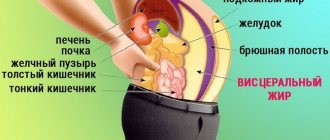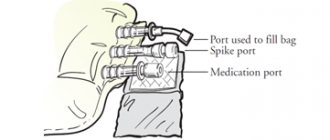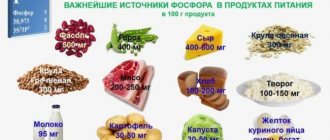- Basic rules for a healthy diet for constipation
- Recommended products for constipation and irregular bowel movements
- Harmful foods for irregular bowel movements and constipation
- Diet for bowel dysfunction and constipation
- Help during constipation
Such unpleasant symptoms as discomfort, a feeling of heaviness, flatulence, irritation and a general deterioration in well-being are just the tip of the iceberg called “constipation”.
When a person has serious bowel retention, it becomes almost impossible to think about anything else, and only one desire arises - to solve the problem as soon as possible. Everyone knows what constipation is, but there is an official definition. Constipation is a condition in which the frequency of bowel movements is less than three times a week. The stool is hard and there is a feeling of fullness1. Some doctors may diagnose constipation if there is no bowel movement within 48 hours. If there is no stool for less than 48 hours, then we can only talk about its delay1. The main cause of constipation is the slow movement of contents inside the intestines2.
The main task of dietary nutrition for constipation is to establish the natural process of intestinal function and restore its motility. In this case, food should be rich in all the elements and vitamins necessary for the body. Be sure to maintain water balance3.
Constipation: definition and types
Constipation refers to difficult or incomplete bowel movements and lack of regular bowel movements. In adults and children over one year old, defecation normally occurs daily, 1–2 times a day. In some cases, the frequency of bowel movements is considered normal once every 2 days, but subject to painless, free, complete and regular bowel movements. For children under one year old, the frequency of stool can vary widely - from 1 time per day to the passage of stool after each feeding. The nature of bowel movements and the density of stool in infants depends mainly on the type of feeding (natural, mixed or artificial).
The following conditions are considered signs of constipation:
- stool retention (no bowel movements for 48 hours or more);
- less than 3 bowel movements per week;
- passage of hard feces;
- pain or difficulty during bowel movements (need to strain);
- a feeling of incomplete bowel movement after passing stool.
There are acute and chronic constipation. Acute ones occur one-time and more often have a clear connection with provoking factors (inadequacies in nutrition, violation of the drinking regime). Chronic constipation worries the patient regularly, and this diagnosis is made if the symptoms of constipation persist for 3 months.
Up to contents
The most effective foods against constipation
Properly cooked meat and fish will significantly improve intestinal motility.
Diet is the most effective method of treating chronic constipation. It not only normalizes intestinal function, but also reduces the load on the liver and pancreas, and helps get rid of stomach problems.
As a rule, a diet for constipation includes a large amount of fiber and liquid, but requires limiting foods that are difficult to digest and cause increased gas formation. There is a list of foods whose regular consumption will significantly improve intestinal motility:
- Flour products. However, this does not mean that you need to indulge in fresh pastries, rolls and pies. Only day-old or dried bread made from wholemeal flour, as well as bran bread, are good for the intestines; you can buy dietary bran, amaranth and rye bread. Rye bread should not be eaten by those who suffer from increased gas formation. You can eat biscuits and crackers, but in limited quantities.
- Meat and fish. Meat does not harm the intestines if it is properly cooked. Lean beef, turkey, boiled chicken breast or in the form of steamed cutlets will not only not harm you, but will also help improve the functioning of the gastrointestinal tract.
- Fruits. For constipation, it is recommended to eat plums, apples, and kiwi. But it’s better to avoid pears and bananas. The fruit can be eaten as a fruit salad with low-fat yogurt. Daily consumption of fruit partially satisfies the body's need for fiber and vitamins.
- Dried fruits. Perhaps this is the best laxative, as well as an irreplaceable source of vitamins. Prunes and dried apricots have long been known for their laxative effect. You can cook compotes from them, eat them just like that, or add them to salads and porridges.
- Vegetables. Vegetables are rich in fiber, but it is advisable to eat them raw. It is better to reduce the consumption of boiled potatoes. There is a salad called “Broom”, which cleanses the intestines better than any laxative. It includes raw carrots, beets, cabbage and greens. This salad is seasoned with oil, but not salted.
Causes
Constipation can be not only an independent disease, but also a symptom of a number of pathologies and conditions. The following are the main causes of constipation:
- Diseases of the gastrointestinal tract: chronic colitis, biliary dyskinesia, gastric ulcer, the presence of obstacles to the passage of feces (tumors, diverticula, etc.).
- Eating disorders: excess fatty foods, insufficient amount of coarse plant fiber in the diet, improper drinking regimen. Depending on the nature of the diet, constipation can be either acute (with single errors in the menu) or chronic.
- Low physical activity - intestinal motility and the speed of passage of feces through it depend on the general activity of the person. With a sedentary lifestyle, irregular bowel movements and difficulty defecating are much more common.
- Other reasons: pregnancy, psychological problems and stress (child entering kindergarten, school, etc.), high temperature (due to intense loss of fluid), taking certain medications, immaturity of the gastrointestinal tract in infants.
Up to contents
What and how can we help you?
- Consult with a competent specialist - our gastroenterologist will examine you in detail, if necessary, prescribe additional consultations with related specialists and monitor the treatment process, from the first visit to the result.
- To identify the cause of constipation - we have all the necessary expert-class equipment and highly qualified diagnostic specialists to conduct a detailed examination - tests, ultrasound, endoscopic examinations.
- Save you time and money - to find out why your intestines are refusing to work regularly, we have created a free conversation with a gastroenterologist to schedule an examination. If you are concerned about your symptoms, but you don’t know where to start, during the conversation you will be prescribed the necessary range of tests.
Constipation is the cause and consequence of many diseases. A competent doctor will help you understand them. You shouldn’t prescribe laxatives to yourself, get carried away with enemas, or delay visiting a gastroenterologist. You may miss something important and waste valuable time. Don't take risks - contact a specialist.
Treatment
Both chronic and acute constipation must be treated to alleviate your condition and avoid complications.
Proper use of laxatives
Regardless of the reasons, treatment of constipation with stool retention for 3 days or more requires preliminary cleansing of the intestines.
For this purpose, the following are most often used:
- laxatives,
- suppositories with glycerin,
- cleansing enemas.
What to do if you have severe constipation? Taking laxatives by mouth (oral) helps very slowly and unpredictably. Moreover, unpleasant side effects may occur, such as increased gas formation, rumbling and cramping abdominal pain. But some oral medications are well suited for the complex treatment of chronic conditions and the prevention of constipation.
The best option for cleansing the intestines during acute, including long-term and severe, stool retention is the drug MICROLAX®, produced in the form of microenemas. Compared to oral laxatives, it can take 5–15 minutes to work1. Other advantages of MICROLAX® include a high safety profile when following the instructions for medical use of the drug (it has no age restrictions or special contraindications) and a convenient release form - microenemas in individual single-use packaging. With the help of MICROLAX® it is very easy to get rid of constipation at home - administering a microenema does not require special skills. It is enough to simply insert the tip into the rectum, after squeezing out a drop of MICROLAX® to lubricate the tip (for a child under 3 years of age, insert the tip only halfway, up to the mark on it, or use MICROLAX® for children) and completely squeeze out the contents of the tube, then remove the tip , still lightly squeezing the tube.
Severe constipation is a common occurrence in hospital patients, especially those who have undergone surgery, and in pregnant women during their stay in the maternity hospital. Problems with bowel movements can also occur on the road (long train trips, business trips). In such situations, MICROLAX® can also help you - it can be used in the postoperative period and during pregnancy, and thanks to its convenient format it is very simple.
MICROLAX® has no restrictions on the duration of use and is suitable for the treatment of chronic constipation. In this case, a complex treatment therapy must be selected by a doctor.
Compliance with diet and drinking regime
To normalize stool, the use of laxatives alone is not enough. Nutrition is of great importance. Activation of intestinal motility, softening of feces and growth of beneficial microflora is promoted by dietary fiber: pectin, lactulose and coarse plant fiber. They are found in large quantities in fresh vegetables, fruits, berries, and grain shells (whole flour, bran, muesli).
Including fermented milk products in the diet - low in fat and fresh, additionally enriched with representatives of normal intestinal microflora (lacto-, bifidobacteria) - helps to get rid of constipation.
To normalize stools, it is imperative to increase fluid intake, in the form of bottled or boiled water.
Increasing physical activity
Regular exercises - gymnastics, swimming, running - contribute to timely cleansing of the intestines.
Solving psychological problems
Psychological problems and stress are common causes of constipation. For a young child, a change of environment, including entering a kindergarten or school, will be stressful. Children are often embarrassed to go to a public toilet and systematically hold back their stool. As a result, the feces become denser, the ampulla of the rectum expands, which leads to painful bowel movements, which is why the child is increasingly afraid to go to the toilet and a vicious circle is formed. Failure to treat this condition in children can lead to the development of serious complications in the future, such as stool, megacolon, rectocele, etc.
In case of constipation in adults, nervous overstrain and chronic stress also play an important role, therefore, in case of chronic problems with stool, the help of a psychologist and training in relaxation techniques would be useful.
Normalization of the daily routine
A normal daily routine is not only about adequate sleep and rest. This also includes achieving regular, daily (and preferably at the same time) bowel movements. The formation of a bowel rhythm is helped by the use of MICROLAX® in the initial stages of treatment - the use of a microenema in the morning helps to develop and strengthen the habit of going to the toilet at this time of the day.
Treatment of the underlying disease
If any disease is the cause of constipation, then to eliminate problems with stool, you must first begin treatment. In case of organic pathology (tumor, diverticula, congenital intestinal anomalies), surgical intervention may be required.
Up to contents
What to do if you are constipated
If you have functional constipation, the following recommendations can help you achieve normal bowel movements:
1) Lifestyle correction.
- There should be no morning rush; you need to set aside enough time to go to the toilet before school or work.
- Sometimes a hearty breakfast is a kind of stimulus for the appearance of stool. The generally accepted ideal time to go to the toilet is 15-30 minutes after breakfast.
- It is very important that you go to the toilet at the same time and regularly, this way we accustom the intestines to normal stool.
- Try to create conditions for a comfortable stay in the toilet, ask your relatives not to disturb you for a certain time, not to rush you.
- If the urge to defecate occurs during the day, do your best to go to the toilet.
2) Exercises to activate intestinal motility.
- Self-massage the abdomen with a circular motion of the palm in a clockwise direction before and during visiting the toilet.
- Before going to the toilet: imitate cycling, exercise the abdominal muscles (for example, inhale air, drawing in the stomach, and then “throw” the stomach forward as you exhale).
3) Nutrition correction. Eating regularly 3-4 times a day, consuming enough liquid (1.5-2 liters of drinks and liquid meals per day in the absence of contraindications), consuming enough fiber are important steps to normalize stool. It is known that residents of our country eat on average 16-18 g of fiber per day with a norm of up to 30-35 g, while in order to maintain this norm, you need to consume at least 400 g of fruits and vegetables per day.
In the absence of contraindications, it is preferable to consume vegetables and fruits raw, while in case of increased intestinal motility, heat treatment of vegetables (cooking, stewing) is mandatory.
Stimulation of stool can be facilitated by the consumption of fermented milk products, dried fruits, vegetable oil, honey (in the absence of contraindications), and the addition of coffee to the diet. By the way, drinking a glass of cool drink (water or juice) in the morning on an empty stomach often has a laxative effect. You can also use some mineral waters as recommended by your doctor. Since easily digestible carbohydrates slow down bowel movements, patients with constipation should limit white cereals (such as rice, semolina) and pasta.
In the modern world, where the Western type of diet predominates, with a large amount of refined foods and easily digestible carbohydrates, it is sometimes very difficult to maintain such a varied diet, so the high prevalence of constipation is not surprising. It is not for nothing that it is considered a disease of civilization. And by the way, another possible cause of constipation associated with modern civilization is the widespread use of toilets.
How are these related, you ask? Look: when sitting on the toilet, the pelvic muscles squeeze the rectum, making it difficult to empty. The most physiological way is to defecate while squatting (as people did at all times before), otherwise it is called the “eagle pose.” In this case, our hips and pelvis create an angle of approximately 35 degrees, there is no pressure on the rectum. However, we are people accustomed to convenience, and, of course, we will not refuse toilets. Therefore, you can use an alternative technique to create the desired body position - using a low footrest next to the toilet. This will automatically lift your legs and create the desired angle.
Constipation in children
If a child experiences constipation, especially chronic constipation, treatment should never be delayed. Prolonged bowel retention only aggravates the problem. The feces become dense and damage the intestinal mucosa, which leads to painful bowel movements - as a result, the child endures and deliberately avoids going to the toilet. Accumulating feces stretch the ampulla of the rectum, and encopresis (fecal incontinence) may subsequently form.
Parents are often interested in what to do if a child is constipated at 1 or 2 years old. The situation with stool retention in a newborn, one-month-old baby or infant becomes even more difficult for mothers and fathers. Young children are scared to use laxatives, especially since many of them are contraindicated at an early age.
To eliminate acute stool retention in a child from the neonatal period, MICROLAX® can be used: it has no age restrictions, and is also approved for infants. If constipation occurs, therapy should be supplemented with other measures - diet, increased fluid intake, increased physical activity.
For newborns and infants who receive only mother's milk, the diet must be followed by a nursing woman. When feeding with formulas, it is recommended to use special nutrition. Infants over 4 months of age need to introduce vegetable and fruit complementary foods in a timely manner.
Up to contents
Why is “normal” constipation dangerous?
Stool retention is not so harmless. Constipation is the cause of many health problems:
- Hemorrhoids worsen, anal fissures appear, and the risk of rectal prolapse is increased - in 7 out of every 10 patients.
- A dysfunction appears - irritable bowel syndrome.
- There are predisposing factors to the development of colitis and allergies.
- The body does not receive the necessary vitamins and minerals.
- The patient becomes irritable, suffers from depression and neurosis.
- Chronic fatigue syndrome is a common concern.
Those who suffer from constipation are at increased risk of:
- diverticulosis of the colon (protrusion and thinning of the intestinal wall) and its complications, up to intestinal perforation and peritonitis - in every fifth
- Intestinal polyps are found in every tenth person
- Colon and rectal cancer affects every 20th person.
Do not take it to extremes - treat constipation in a timely manner.
Constipation in pregnant and lactating women
Due to hormonal changes in the body of pregnant women, as well as against the background of compression of intestinal loops by the growing fetus during the period of bearing a child, and then during feeding, constipation often appears.
Meanwhile, many laxatives are contraindicated for pregnant and lactating women. Changing your diet and increasing physical activity (within permitted limits) also do not always give a positive result.
For treatment at home and during a stay in the maternity hospital, pregnant women can use MICROLAX®, which is suitable for both the expectant mother and the child. It can be used for a long time, so it is also suitable for combating chronic constipation in pregnant women.
Up to contents
In conclusion, here are a few interesting clinical cases from our practice:
Constipation and... thyroid: where is the connection?
A young girl, 23 years old, contacted us. It turned out that she had been suffering from constipation for 1.5 years! Our doctor carefully interviewed the patient and found out that during pregnancy, 3 years ago, she was diagnosed with a dysfunction of the thyroid gland, but nothing bothered her and no treatment was carried out.
We examined her more thoroughly and found out that the cause of constipation was autoimmune thyroiditis - a common situation in women, when the body “attacks” its own thyroid gland, it is gradually destroyed and the level of hormones drops. One of the symptoms of autoimmune thyroiditis is constipation. Our endocrinologist prescribed treatment, the function of the thyroid gland returned to normal, and joint work with a gastroenterologist yielded results - the constipation went away.
Constipation and something else
A 67-year-old patient came to us with complaints of constipation. Laxatives didn't help. The doctor examined him, but found no significant abnormalities. However, the age and nature of the complaints were alarming, and the patient was sent for a detailed examination.
A blood test revealed a decrease in hemoglobin, an increase in ESR, and occult blood in the stool using the ultrasensitive Colon View test for occult blood in the stool. We performed a colonoscopy, an examination of the intestines using a flexible endoscope, and identified an intestinal tumor. Luckily, we made it on time.
The patient was successfully operated on and is under the supervision of a gastroenterologist and oncologist.
Do you need to take a laxative?
Many people suffering from constipation do not worry too much about this, due to the fact that they can use laxatives at any time. This makes it easier to have a bowel movement, but research shows that frequent use of laxatives can cause some dependence on them. There may even come a time when a person will no longer be able to empty his bowels without these drugs. Over time, in addition to dependence on these drugs, due to the body’s addiction, it will also be necessary to increase the dosage of laxatives, which will also negatively affect human health. If you are planning to take laxatives, you should first consult your doctor about how often you can take these medications and whether it is safe to take them on a regular basis or not.
Safe ways to deal with constipation
To painlessly eliminate the problem, you will need 2 tbsp. l. steam wheat or oat bran in a glass of hot milk. Pour the mixture into a thermos. After 2 hours, cool the broth slightly and drink along with the bran. The effect will occur within 2–3 hours.
Another remedy: 2 tbsp. l. pour senna herbs and 6 prunes with a glass of boiling water. Leave until the dried fruits swell, strain and drink the liquid. Then eat prunes. In a few hours, constipation will only be a memory.
Complications
The causes and consequences of constipation may be interrelated. For example, with proctogenic constipation, complications in the anorectal area develop faster: if defecation delay is associated with the appearance of hemorrhoids, then this condition will quickly lead to exacerbation of inflammation, thrombosis and other complications.
If stool retention does not occur as a result of anorectal pathologies, it quickly leads to them - it is one of the main causes of anal fissures, accompanied by bleeding, as well as complications associated with damage to the mucous membranes. These include cryptitis, paraproctitis, and pararectal abscesses that require urgent surgical intervention.
Complications from the digestive system such as:
- inflammatory diseases: colitis, proctitis, etc.;
- intestinal diverticulosis;
- stretching of the walls of individual sections of the colon, or megacolon.
One of the most serious complications of prolonged delay in bowel movement is acute intestinal obstruction. It requires urgent surgical intervention. Obstruction, in which there is no timely assistance, threatens to result in necrotic changes and death.
A delayed consequence of prolonged constipation may be deterioration of chronic diseases. Chronic intoxication with waste products that the body cannot get rid of can become one of the causes of exacerbation of allergic diseases, deterioration of the body's resistance to infections, as well as exacerbation of dermatological diseases.
The accumulation of feces increases the risk of developing diseases of the genitourinary system, since surrounding organs are compressed. Thus, stool retention can aggravate the condition of diseases of the bladder or reproductive organs in women.
With chronic constipation, the risk of developing atherosclerosis significantly increases due to increased cholesterol levels. In addition, delayed bowel movements are a risk factor for colorectal cancer.
Is constipation dangerous? Yes, because it can cause tumor diseases. There are several mechanisms for the development of malignant neoplasms. One of them is the accumulation and stagnation of feces in the intestines, which leads to the release of carcinogenic compounds. Their long-term effect on the intestinal walls leads to tissue changes.
Regular bowel movements are one of the mechanisms for the disposal of “bad” cholesterol. In the absence of timely release of the digestive system, lipid metabolism changes, and the likelihood of the formation of atherosclerotic plaques in the lumens of blood vessels increases. This leads to a significant increase in the risk of cardiovascular diseases, heart attacks, and strokes.
How to get rid of constipation at home for an adult in a matter of time
Unexpectedly, constipation occurred, what to do on your own in this case. The thought of laxatives immediately comes to mind; they can be taken at any time. This is the fastest way to go to the toilet normally, but experts do not recommend constantly resorting to this method. Over time, the drugs become addictive to the body, and it stops coping on its own. There are several folk recipes to urgently cleanse the intestines at home.
Oil based enema.
You can resort to an enema, it effectively copes with constipation. There are also disadvantages to this method; frequent use leads to dysbacteriosis.
The walls of the rectum are stretched under the pressure of the solution, and muscle activity weakens. If the disease is not a frequent companion, an enema will do its job well.
It is better to make a solution based on oils, such as Vaseline or sunflower. Heated to 38 degrees and carefully introduced into the body. Its effect is mild and begins to help after 10-12 hours. It is advisable to carry out the procedure before bedtime.
Salt based enema.
If there is severe stagnation, you need to urgently make a solution with salt. Add 1 tablespoon of salt to 2 liters of water. Can be used once. This solution makes the stool looser, forcing peristalsis to work.
However, do not get carried away with the process and the number of tablespoons of salt. If you do more procedures or add more salt, you can get irritation of the walls of the esophagus.









